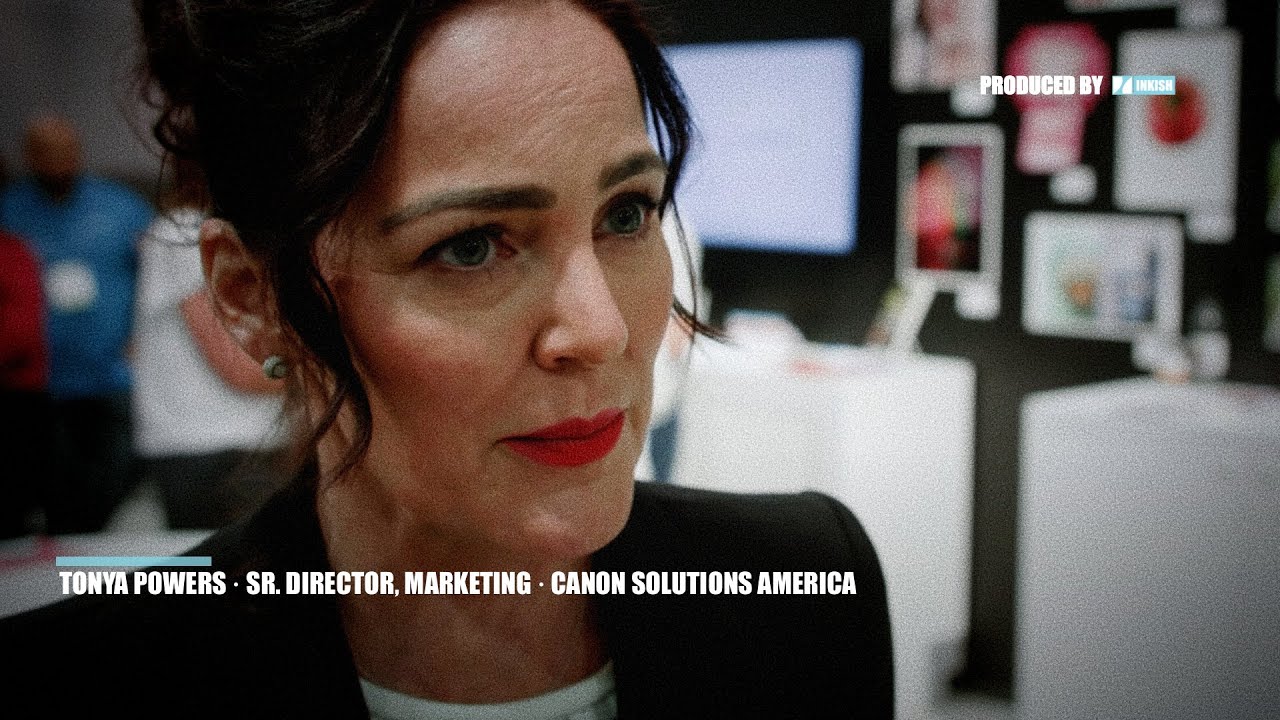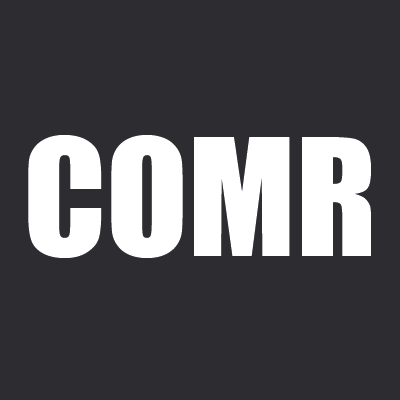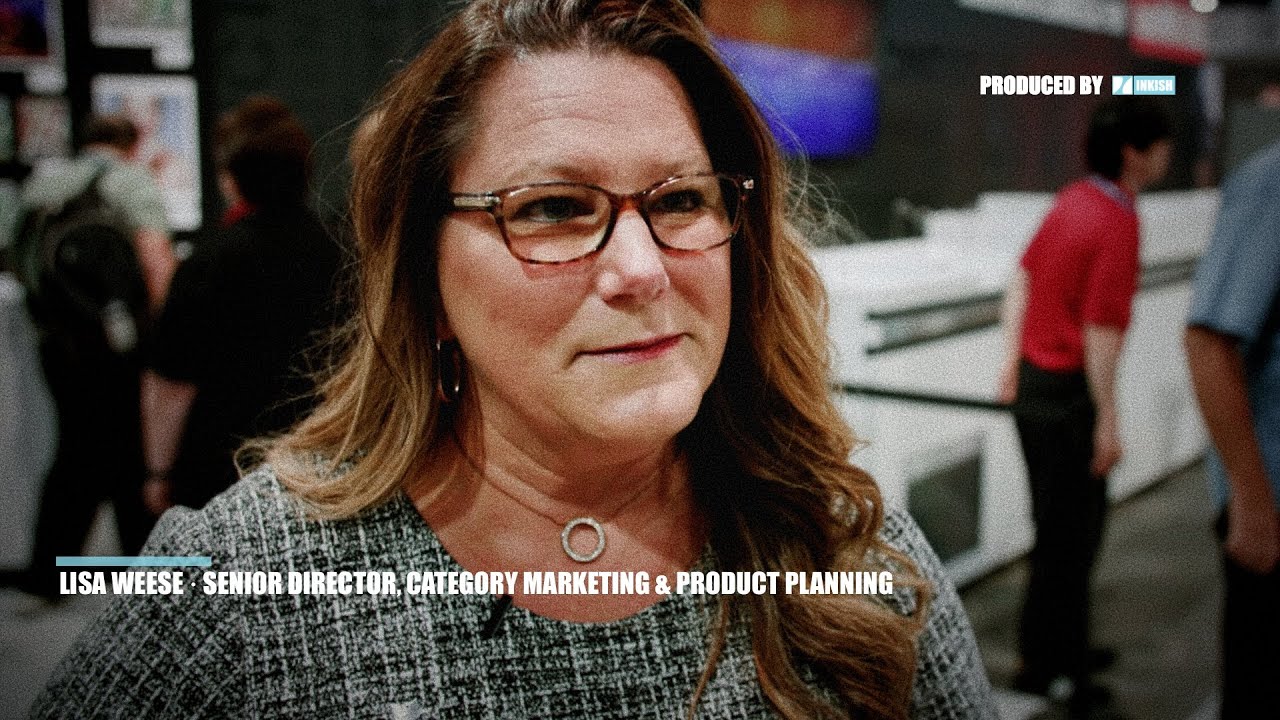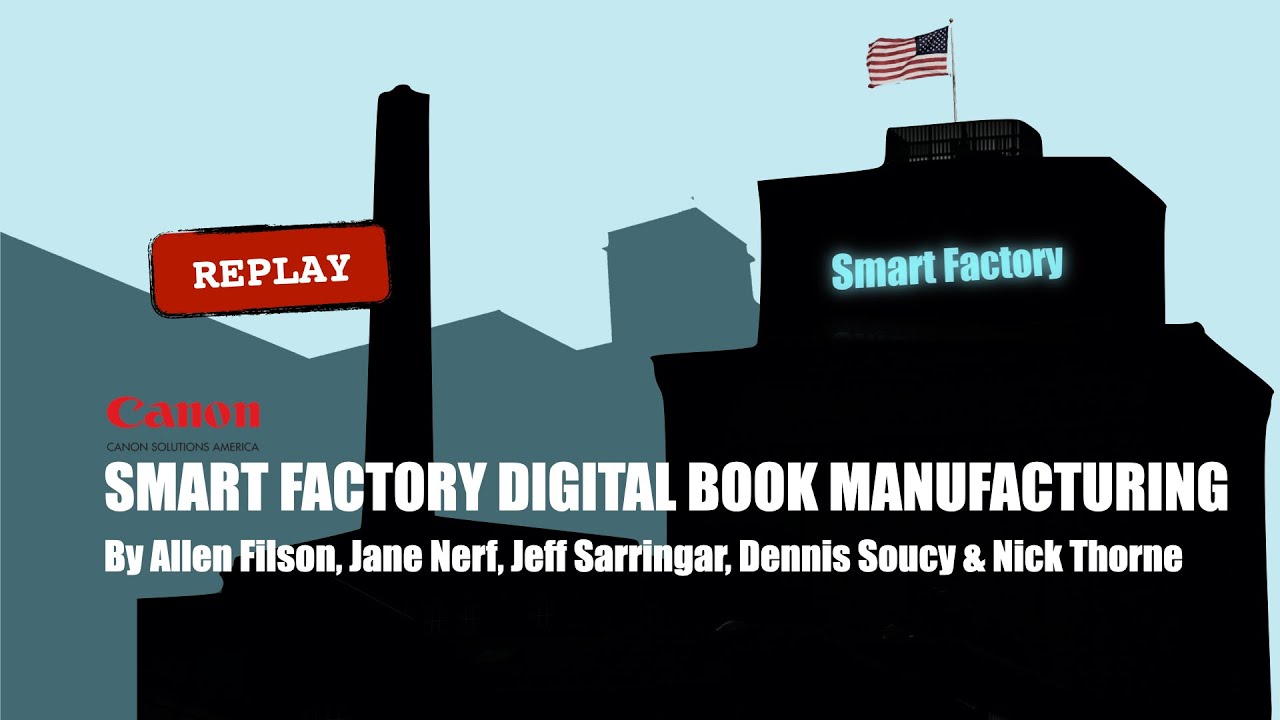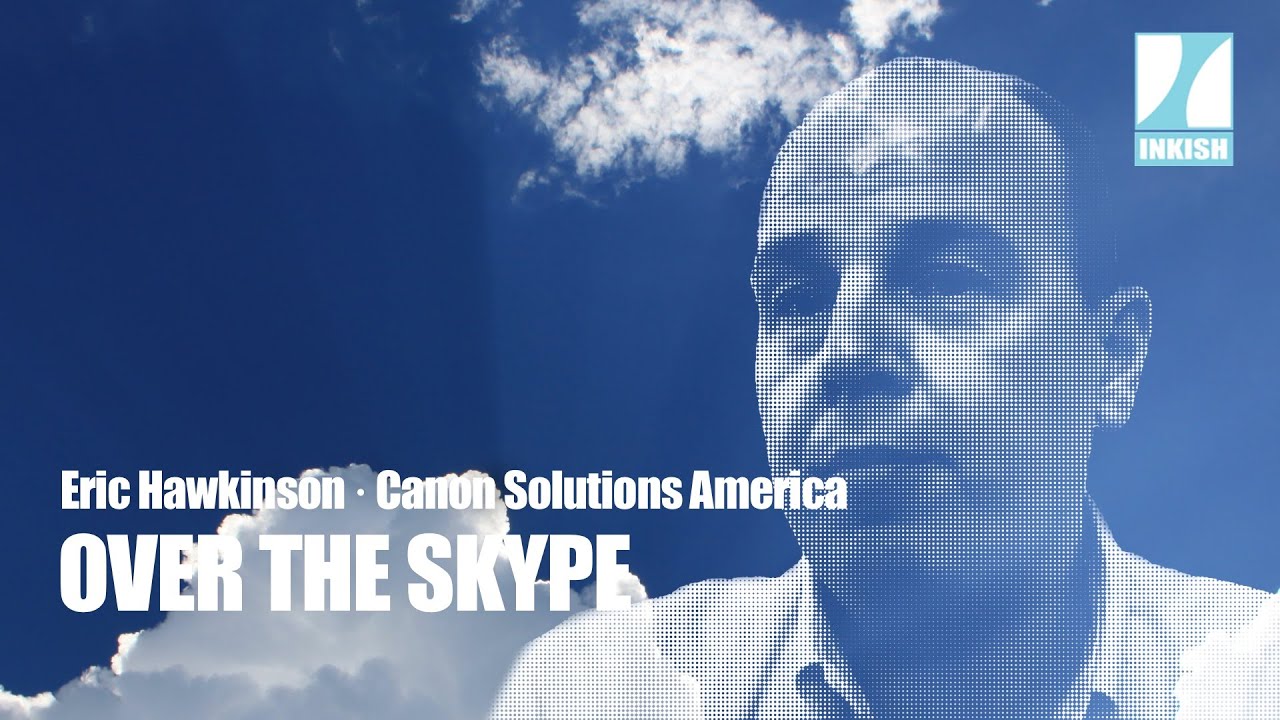Michael Poulin · Over The Skype · Canon Solutions America
In this ‘Over the Skype’ session, we talk to Director, Product Marketing, Michael Poulin from Canon Solutions America. As you can hear in the conversation, we have spoken with Michael Poulin at the last Printing United – LIVE from the Canon booth – about partner programs, etc. In this session, we also touch upon partners, but of course, more about the inkjet devices from Canon iX-series, color-stream, and pro-stream – and, of course, all the important things to know before investing in inkjet.
Great talking to Michael Poulin again.
This is a Morten from INKISH.TV and this time I’m a little embarrassed because I have actually spoken to the gentleman that we’re going to meet in a second, before, and I totally forgot. See, that is when you have so much traveling, so many people to meet. And now, he has got the liberty to grow a beard and get a little bit hair less, but welcome… please welcome Michael Poulin from Canon Solutions America. Ah, he has a phone, so he needs to take that first. Michael, please introduce yourself.
You caught me just as my rang, that was perfect. Perfect timing. Thank you, Morten. Thank you for having me today. As you said, Michael Poulin, I’m the Director of Product Marketing for Canon Solutions America, responsible for all of our continuous-feed equipment and for Partner Programs. I think we spoke about
Oh yeah. We’ve spoken about… That was quite interesting because… Now, we’re jumping directly into it, but I remember that I was quite amazed because of the red thread through all the interviews I did with you and your colleagues and your customers at PRINTING United, last year, I got the impression that you are very, very good at partnering with people and get into a close relationship. And I even remember one of your customers saying that Canon Solutions America is it’s more like a partner than a vendor, so that is a good starting point, isn’t it?
It is. And thank you for that. That’s… It’s always good to hear from our partners. We spend a lot of time trying to take care of them. Obviously, we have our own products and I know you’re gonna talk about our new announcement of the ProStream 1800. We’re very proud about that. But yeah, the Partner Program and what we’ve done with it has been great. We’ve really been focusing on that for the past few years and really trying to bring it up. We’ve… As we spoke about, we created what we call the Unified Partner Program, where we put all the partners under one group, under me and my team. That’s allowed us to actually pay a little more attention and to do some things and consolidate some things that have really helped. And where we saw that is in all the cooperation we had last year at events, but especially, at thINK. And so, think last year we had the most partners that we’ve ever had. Even in this year, with the COVID situation and with thINK going virtual, we’ve got a pretty good turnout with our partners, so we’ve been pretty happy with that. So it’s going quite well. And I think our customers see it more than we do. They see that partnership that we have. They see that the cooperation that our sales reps and the partner sales reps have. It allows it, it allows them, to be a little more comfortable with what we’re presenting to them, to make sure it’s going to fit their needs. It makes it easier for both sides, so it really is, to use cliche, a win-win. It is for everyone.
But what’s the use, using a cliche like a it’s a win-win situation, but when it is a win-win situation, I think it’s okay to use the use the term, right?
I hope so!
One of the things I was a little bit curious about when you talk about the partners and maybe especially during the COVID-19, because maybe it’s just something that I think about, but I was thinking in the COVID-19. I think it’s… A lot of people are very concerned about how to sell. Let’s say the PSP is starting from their point. How do they get the sales across to their people? Because the demand is obviously changing due to the COVID-19, but that influences, also, your opportunities to go into the market, right? And, before you answered that directly, I’m a little bit curious because the Partner Programs, does it mean that you have a lot of entrance points to the sales, basically?
It does allow us a few additional entrance points, especially, we have our Finishing Partners, our Workflow, Third Party Workflow Partners, and our Media Partners. Our Finishing Partners, in many cases, we’ve been in those accounts for a very long time and we know them quite well, but there are some opportunities there. The Workflow brings us into, probably, more opportunities than Finishing and the Media, of all, are the surprising accounts where they bring us into places we’ve never been to, especially into the commercial print space that really hasn’t dealt with digital before. And we had a lot of success getting into those types of environments. And to bring that back to your other question about the COVID-19 situation, it is the commercial printers who I feel are taking the biggest brunt of this. So, when you look at the markets that we serve, the direct mail is still pretty strong. You’re still getting a lot of mail on your mailbox. Maybe down a little bit, but not too bad. Transactional, and especially in the healthcare workplace and that marketplace, a lot of activity there, of course. But the commercial printers, a lot of companies have had to cut back and they’ve cut back on advertising and things that typically use commercial print marketspace. So, in that respect, it’s been a little bit difficult. So we’ve had a few successes there. Obviously, the new announcement of the ProStream 1800 will allow us to bring even more capability into that marketspace. And we’ve been not so bad, actually, from a business-wide perspective, we’ve been doing quite well. Canada, as a whole, has been doing quite well through this time. But also, the other side of that, is we also announced the varioPRINT iX Series a few months ago, and that’s a sheet-fed device. A little bit smaller and probably a little bit better for that marketspace. So the response to that machine has been exceptional because of the little bit better price point and a little more flexibility with the sheet-fed operation, so that actually did quite well during the roughest times of this pandemic. And now that we’re starting to come out of it, we think we’re gonna see a little more activity on the continuous-feed side with the ProStream.
Before we… I would like to hear more about the machines in a second, but before we go into the details about this, I was a little bit curious because, during all these interviews I’ve done, here, via Skype, I was… I had been asking a lot of people, “Do you think that COVID-19, and the pandemic in general, is kind of a initiator for the change to more digital? Because maybe print volume changes, maybe a mass customization finally gets to wider acceptance and these kinds of things. So, is that a good opportunity for inkjet and toner-based devices, in general? Better than it used to be?
You know, I think it is. Exactly what you said. There’s a… If a company is, now… They’re tightening their budgets, right? So, those marketing budgets are getting slimmer and they need to make sure that when they’re marketing, they’re marketing to the right people at the right time, and it’s going to be very, even more targeted than it ever has been. To just have a… To just blanket something out there and send a big direct mail campaign. The return on that is so low. So, with the higher returns on direct targeted marketing and the capabilities of digital equipment, I think the volumes are definitely growing in that area. And then, you just look at some of the industry reports. The typical… The industry news and the analysts, and they agree with that. And we’re starting to see that. And we’re actually starting to see some rebound in volumes, too. And it is going on to some of the very high speed, full color engines, like the ones I’ve mentioned, the ProStream and the iX, and that’s exactly for that type of marketplace. So these companies that are spending their money, they’re spending it wisely and putting it where they’re gonna get the best return. So, I agree.
And I spoke to a printer in Los Angeles, yesterday, unfortunately, not a Canon good customer, but regardless, he mentioned those…
We can fiX that.
You can fiX that, I’m sure. So I was just wondering, part of the conversation, when you change the technology, it, obviously, is the revenue potentials and the profit potentials higher with technology like inkjet. And I think that, in these times, where you say there is a shift, that there maybe is an interest for the brands to be more specific in their marketing, more direct in whatever they do. I think it’s also… Even though the volumes are maybe lower per print run, the value and the profit per print, or per whatever campaign you do, can be significantly higher, right?
Right. And with engines like the ProStream and the iX and the ColorStream, and all of our inkjet products, inkjet offers a very good solution, very high quality, very high speed, but also at a very competitive, even low, price. So, obviously with these targeted campaigns they’re generally smaller, they’re variable print, so you have two options when you go with this variable print. You either run a pre-printed shells and you vary the monochrome black and white, put it on toner or monochrome engines, or you do the full color implementation on an inkjet device. And bringing it over to that full color is really cost beneficial for these short runs. And when I say short runs, the short runs are getting longer. And as the speeds of the products increase, again, I’ll tie it back to the 1800 announcement,
You had to, you had to, you had to, right?
With the speed increase, it allows you to get longer and longer runs in a shorter time period. So it condenses that window and it condenses those costs. So, for runs up to a half a million impressions, or a half a million books or a half a million catalogs or whatever it could be, that’s easily done.
But that is one thing.
Or five million. It depends on the application. It could go significantly higher than that.
That is, of course, one thing, but I think that also one of the things that a lot of people talking about when in relating to, for example, inkjet is also that you have fewer touch points. So if you, for example, want to make a variable campaign, as you said, if you pre-print things and you add at the monochrome to it, there’s an additional process to it, and it’s time consuming. And I think that maybe one of the things that everybody’s learning from the pandemic is that you need to get the work done with your people, right?
Exactly. So I think that’s a great point with the touch points and the speed and the turnaround. So one of our great customers, SG360, they have a video on our website and their VP of Marketing said that the typical turnaround time of an analog or an offset job is about 7-14 days. And she said that just simply is not acceptable anymore. They need a 2-3 day turnaround. And with the fewer touch points and the inline processing and all of the things that we can bring and the simplified workflow and the simplified pre-press, all of those things enable them to do these turnarounds. And they can get targeted mail campaigns in the mail in two days or less. So that really reduces that time. And it not only makes it a targeted campaign, it makes it quite more relevant, right? So it’s the timeliness of it. Though, if you purchase something today and you get something in the mail within two days, that is associated to that purchase, it has a lot more effect than if it’s two or three weeks down the road. So that’s a key, as well.
One of the things that you, obviously, are talking about here is how to use it as trans-promo and transactional kind of relation, too, and the mass customization, all of these things. I’m a little bit curious because you obviously know a lot about the market, so I have a little interest in knowing, and maybe I’m saying something that you can prove me wrong, but my assumption is that if you look at digital print in broad perspective, both toner and inkjet, then obviously both technologies has been in the market for a long time now, and now it’s maturing. Both technologies are maturing. If you look at, especially, the commercial printers that you are obviously interested in attracting to both the iX and maybe also to the roll-based printers, what is… Maybe I’m not phrasing my questions so good, what I’m curious about is that, when I used to work in a printing company, the digital presses, the toner or the inkjet, were way more like just replacement of smaller offset machines. So you didn’t use virtualization, personalization all these things that the digital machines can do. Is that something that you recognize, also, when you talk to the customers in the U.S.?
There is some of that, of course. There is some customers who are just simply moving some of the offset work over to the digital presses, but for the most part, they own those offset, they have the people in place, and there are a number of jobs that are just going to continue to run on those. What we’ve done is also help those customers move those jobs over to the digital. So it’s not… And we’re a full service company, right? It’s not just the hardware. We have a complete Service organization and a Professional Services organization. And one of the key features of the Professional Services organization is that they come into the account and not only before the sale, to make sure that you’re getting the equipment and the finishing and the workflow solutions that you need, but also after the sale to help you help train your people, to get them on board and to identify new opportunities. Especially with new accounts. So new accounts, I think, have the most trouble where their internal salespeople don’t necessarily know how to sell digital. So they could have been selling offset work for their entire lives and now, they have to go sell this digital print and it’s variable on how do I sell this, so we can help train people on that. And then, we can help identify applications that can come over. We literally walk through their environment with them and say, “Okay, how are you printing this today?” We’ll pick a piece up. “Okay, you’re putting this on an offset, and this is what you do.” And we help transfer those jobs over.
But that is exactly my point because I think that let’s say that this film is seen by people that are considering investing in inkjet, right? And maybe they want to get in touch with Canon because they believe that you have everything that is right for their company. And let’s say that you have a quite considerably amount of job that does need to be digital, but you really want to also have customers that are digital and you want to get rid of your offset presses, right? I’m just wondering, if you look at the cost base of moving jobs from offset to digital, if it’s not taking advantage of the things that you just mentioned, does that make sense? Or is it still like a phase where you need to have both technologies?
It kind of really depends on the application. How big the application is. If you’re printing millions and millions and millions of static work, then at some point, yeah at some point, the crossover gets pushed out far enough that it just makes more sense on offset. But as I was saying earlier, that number is getting bigger and bigger. And there are applications… I think I was saying 500,000 before. I just looked at some notes over here and it’s about 5 million on some applications!
Wow!
So, it could be, it depends on the application and the run. So that’s really the key, is what the application is and the length of that application. That said, even for those customers that just want to convert everything over, we have a few that have done that. And the price point of the inkjet product is such that you can still make money, it’s still competitive, even on those long run applications that are static. And then, of course, we would encourage you to make that a little more variable, to get that little more marketing turnaround or your return on investment out of it.
To have a bit of value for both yourself and the customers, right?
Yeah.
Yeah. So, and one of the things that I think that is, of course, extremely interesting with both the iX Series and the ColorStream and the ProStream is also the fact that, if people in the past was worried about quality, that is not an issue anymore, is it?
No, not at all. So, I’ll boast a little bit. The ProStream won several awards last year. So the Great Lakes Graphic Arts Association, we won a Benny Award, here, we won some SGI awards and others, and just… The quality is no longer a concern. And that’s great to say, but then you talk to our customers. What do our customers say? And I think one of them put it best. They just said, “Quality is not a consideration anymore when I’m buying a machine.” So it’s it’s not even considered. The quality on these… I’m sorry. The quality on these devices.. You are comparing to offset, right? That’s the benchmark. With both the iX and the ProStream, we can achieve greater than offset color gamut. So if you’re using a GRACoL 2013 Coated as your reference, depending on the paper, it could be 40 to 50% more colors that you can produce on one of these engines than you can on an offset. So the resolution is there for the fine line detail, the color gamut is there. The medias are there with all the offset coated papers. So, it’s just simply not an argument anymore.
I spoke to your colleagues in the Netherlands, Heigu Fungal and Uter Hendrix. And that was specifically in relation to the iX Series, because I think that one of the things that both the i300 Series and the iX Series has been ever renowned for is the ColorGrip and the technology that allows you to print on a multiple range of substrates. Also, your new iQuarius drying technology on the iX Series is something that gives a lot of productivity. Is that… And that color thing, is that something that you also see on your roll-based printing machines now? That you can do similar things? Or are they very different?
Yes, it is. It’s a very similar product, so the ColorGrip, we use ColorGrip on the ProStream Series, as well. It’s a slight variant ’cause the ink is slightly different, but it’s the same basic concept and the same basic technology. With the iX being a sheet-fed and a little bit slower, and the speeds and the different drying time of the continuous web on the ProStream, there are some differences, but it’s essentially, it’s the same concept. It’s a conditioning fluid that does several things. So, the first and foremost, it lays down… It conditions the paper. Paper is a organic substance and there’s a lot of variations in it, and depending on the quality of the paper, from which mill. And then, every mill has different quality levels. So, one of the great things that ColorGrip does is it kind of evens that quality out across the page. So, slight variations in paper, it evens that out. So it gets you a much better overall color gamut, and good solids and good shadings, but it also allows the ink to bond to those coatings. The coated media was produced for offset ink, and it’s made to accept that oil-based offset ink. Doesn’t do well with water-based inkjet ink. So, the ColorGrip allows that connection to be made and keeps it highly robust. One of the questions we get a lot is, “Do I need to coat after I print on this?” And when you go look at some of the old toner technology or the liquid toner or the dry toner, a lot of that had to be coated because when you printed on those high gloss papers, all that toner sat on top of the surface and when you sent it into the mailstream, it would get rubbed off. So, with the ColorGrip and our ink technology, that no longer happens. We have direct mail companies that are sending millions of postcards a month out into the mail and they’re doing just great. So there’s a lot of advantages the ColorGrip brings.
And is the ColorGrip new to the 1800 or is that something that also works in the previous models?
That was in the 1000, as well. And in fact, the previous model ProStream 1000 and the 1800, we’re using the same ink, the same print heads, and the same ColorGrip. So your overall color and image quality is virtually identical. We just boosted the speed.
Okay. And…
And most of that was gained in the drying process.
Okay. And when you decided to come to this upgrade and focus on the speed, is that because you can, or is it because there’s a need for it.
A little of both. It was… It’s been part of the roadmap on the engine since its beginning. So we always knew that this was coming. But some of the marketplace is asking for it. So we’ve always… One of the features of the ProStream is, we’ve always been able to print on heavy coated media, and we’ve been the fastest in the market on the heavy coated media, on the nine point, since the introduction of the ProStream. So that’s always been an advantage for our engine, but some of our competitors have been able to run on the lighter weights or on the uncoated medias a little bit faster. So this levels that playing field on the uncoated side, and it brings the speed up, there. So some of our commercial print book printers in the book markets, this will allow them to run that lighter weight, uncoated medias a little bit faster and really play a little bit better in that marketplace. But we’ve been doing quite well on the heavier coated papers.
So, to conclude on this, it sounds to me like that the faster speed brings a bigger diversity to the machine because you can print on a higher speed and be more competitive in different feature qualities, right?
Yes. And in different marketplaces, yes.
So what is… Who is the typical customer for the ColorStream and the ProStreams?
So, ColorStream would be more of the transactional marketspace, the direct mail, the high volume direct mail. That and any of the uncoated space. So the ColorStream is our uncoated inkjet device. Very high quality, very reliable. I think the number, now, is up to over 1,400 ColorStream engines worldwide. So the product is a few years old, but it is just rock solid and it’s been… It’s just done incredibly well. Overall, on our entire continuous-feed line, we have over 1,700 engines. And the number of ProStreams are growing. So the ProStream is the commercial print engine for us and the iX on the sheet-fed side. But on the continuous side, it’s the ProStream. And that’s really targeted towards the… Still with the direct mail, but the very high end direct mail, the premium direct mail, coated papers, the commercial print general, commercial printspace, the book segment, as well, both on very lightweight, we can go down to a 40 GSM and have a very heavyweight on the commercial print with up to 300 GSM.
And so, if you…
So, a very good range on the commercial side.
Yeah. And if you look at… Because one of the things I can’t help think about when you talk about commercial print, one thing is that, I think that’s politically correct to address that you go for the commercial print market. And I think that a lot of inkjet vendors are now, also, saying that if we can take some… If we can replace our technology with some of the offset machines, it’s not bad, but to be a 100% fair to the market, aren’t you not trying also to, with high quality and high speed, also to address, without mentioning anybody, but specific customers that are competing with you? Vendors competing with you?
Well, I like to think that they’re trying to compete with us.
Okay, so they’re compete with you. I like that.
We set the benchmark and they can try to catch up.
Okay, so I should call them instead. That’s what you said, right? No, to be honest Michael, I think that I will mention the name. If you look at the Indigo’s and HP, I know it’s toner-based, but they have… It seems to me that they have a very strong position in the market, obviously. And I think that, with more and more people delivering these high quality machines, the competitive in the market becomes a little bit stronger. So, I was just wondering, what the KPIs for choosing a Canon device, instead of, let’s say HP. Do you have some good recommendations there?
Well, I’ve… Always very careful about what I say about our competitors, because I respect everything they do and the engines and the products that they have. So I don’t want to talk, specifically. What I can say is, the…
I’m not asking you for any specific competitor’s thing. I’m more like… Why is people should choose a Canon product? I guess that is what you do, right?
Exactly. So in that respect, the quality level of a ProStream, we have compared it to other inkjets, of course, to toner, and, of course, liquidity inkjet. Or liquid toner. So, we have compared that. And we feel, and our customers feel, and the industry shows that the quality is as good or better, in many cases. We know that the pricing for inkjet is typically 30 to 40% lower than the liquid toner engine. We’ve proven that in many factors. So, that’s kind of the…
So there’s also a price point to it. There’s also a price point to it.
Yes, exactly.
Makes sense.
Yeah. So, that’s the tact we take when we’re talking about other technologies and other vendors. And then, probably the biggest part, is what else Canon can bring to the table. As I said earlier, it’s a full service company. Our service and support is, bar none, the best in the industry. We have an incredible Professional Services team, the best marketing team in the industry, if I do say so myself!
Of course, of course!
And just the… And the power of Canon behind us. So, the technology itself and everything that Canon Solutions America can bring. So, I think that’s the real differentiator.
And I would say that it sometimes it can be difficult to be an unbiased media, but I can tell you, for sure, that when I talked to PSPs, not only in America, but also in Europe, Canon has a very, very good reputation for both your service and also the pre-sales and that kind of work. And I think that that is, maybe… I spoke to one of your competitors from Ricoh a couple of weeks ago. And as he said, “For us, it’s becoming more and more a selling argument, also, to have a kind of consultancy role with our customers. So we can give them the right advices in not just in the short term investment, but also in the long term business relationship.” And I think that Canon is in a very good situation in that perspective, as well.
Well, thank you for that. That’s good to hear. It’s good to know that all of our efforts are recognized. And we know that even… I talk, exclusively, of Canon Solutions America, but I have a very good relationship with the factory, we’ve worked, I speak to them several times a week, and I know that both in the factory and in the European organization, many of the same things we do here. Their Marketing team is amazing, the engineers are amazing. So, it’s good to hear that the industry and the press and the analysts like yourself are recognizing that.
That’s what I hear, anyway, so maybe they don’t tell me the truth, but I believe it! So, Michael, we are here on our 30 minutes. What should we talk about the next five minutes before we close the show. Do you have anything you want to talk about? Oh, that was a hard…
I would like to just talk a little bit about… Sorry?
That was a hard one, right?
I spoke a little bit about the engine. I do wanna talk a little bit more about it. Like I said in the beginning, we just announced the ProStream 1800. This is the latest product from us, really focusing on that commercial print marketspace. Just a little bit about it. We had a 66% speed increase. So we’re now at 436 feet per minute. That equates to 11,300 B2 sheets per hour. So, some of our customers like to convert that to a B2 sheet, Sheet size or a half-sheet size in the U.S. So that’s a significant amount. And even though it’s a continuous-feed engine, having that sheet output typically resonates well with everyone, so I’ll throw that number out there. We have the widest print width in the industry, so a lot of flexibility on what you can put on those sheets or on that output. And then, other features of the engine are the flexibility of media, the overall uptime. So, on the ProStream line, we’ve done quite well with the ProStream 1000 and as we roll into the ProStream 1800, we expect the uptime and reliability to be the same. And that is upwards of 94 to 95%. So, excellent uptime. And, as I said earlier, the quality recognition from some of these industries, some of the marketplaces, has just been excellent.
One of the things I was a bit curious about, due to this pandemic, thINK Ahead goes virtual. So, not an opportunity to go to Boca Raton for this year. How can people get to experience the machine? Do you send print samples, or do you have like films online? Can you schedule demos online? How does that work, now in these times?
That’s a great question. So, the first thing we’re going to do is we’ll be hosting a series of open houses, which will be virtual, of course. And right now, we still don’t have a fully functional machine in the Boca Raton CIC. So that should be up and running in the next few weeks, but for now, what we’re doing is we’re working with the team back in Germany and the factory, and we’re doing some virtual open house demonstrations for our customer. So, our sales reps will be talking to their customers about that and we’ll be posting some dates for that very soon. After that, we know that even once we have the machine in the Boca CEC, some people are gonna be reluctant to fly and to come down and visit us, so we’re also establishing a virtual presence in the Boca CEC. So we’ll have a virtual demos available. We have a camera system. Canon cameras, of course.
Canon cameras, of course! And we’ll have a virtual demo system, so we’ll be able to meet with customers just like we are now and it’ll be a mobile platform where we can give a full demonstration. And then, we’re gonna continue that as we go forward. So, even when everything is quote-unquote back to normal, we expect to continue that virtual piece, where we’ll offer, even if you do come down to Boca, but you have several people back in your office that weren’t able to come down, they can share in the demo experience. So, we would do it with you live and do it with a few people live, and then, have the virtual. So you could have 20, 30 people at your office also part of that. So we’re gonna continue this virtual meetings for as long as we need to. And we think we’re going to have some success with it.
Michael Poulin. It was, as usual, a pleasure to talk to you and thank you for sharing some of the insights. I hope my questions were okay, clear for not being American. So, thank you once again, anyway.
They were great!
Okay, so thank you very much.
All right, Morten. Thank you!

































































